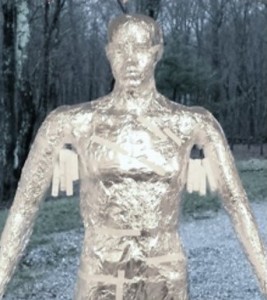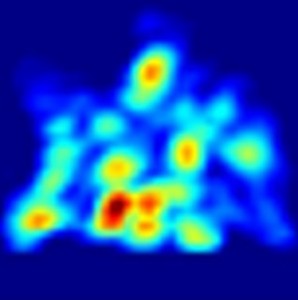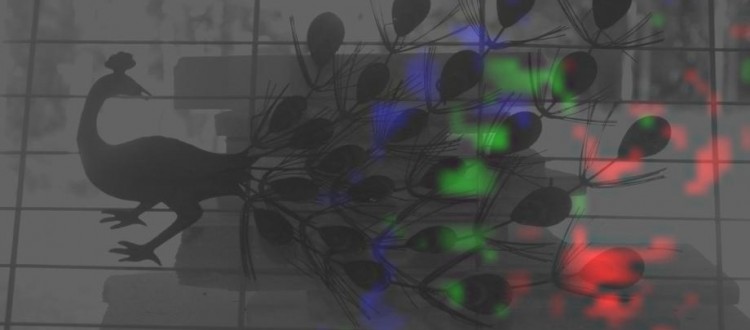A Camera that Can See Through Walls
Humans cannot see through walls. Even out in the open, they can’t see too far on a foggy day. Ditto for search-and-rescue robots or self-driving cars with cameras for eyes. MIT researchers have hit upon a way to give those cameras an ability to see through walls and bad weather. While most materials will stop visible light dead in its tracks, radio wave and microwaves with their longer wavelength can go straight through these objects. Still, conventional microwave or radar-detecting systems are huge, complex, and expensive and cannot be stand-ins for an automaton’s computer vision eyes. Researchers from the Camera Culture Group at MIT have developed a simple camera-like architecture to create a novel radar for everyday objects. They describe their set-up in this week’s online edition of Science Reports.
It is not meant to be the next camera for consumers — the idea is to help with imaging in dangerous conditions, and to help with nondestructive testing. First author of this paper, Gregory Charvat, a visiting research scientist at the MIT Media Lab, explains how the system works. To illuminate the scene, the camera uses a microwave-radiating flash. “When these pulses encounter an obstacle, they scatter off of the object being imaged, just as sunlight scatters off of everything to illuminate objects during the day,” he says. A sensor, which acts like a lens, collects the microwaves that journey back to the device, processes them, and renders a high-resolution image. Using microwaves is not without challenges. At larger wavelengths, surfaces appear mirror-like, making it hard to make sense of the image. The team’s solution was to use multiple sources of illumination and fuse the various images together using computational photography to get a more complete picture. The researchers have demonstrated that the microwave camera can detect the presence of a plastic mannequin in free space, behind a dry wall, and behind plywood. Plastic is transparent to microwaves, but humans are made of water and are reflective to microwaves – hence they wrapped the dummy in aluminum foil and made a “metal guy.” 
 Flat images of the metal guy are not all that the set-up can produce. It can capture 3-D images of objects. Here too, the microwave source acts as a flash, transmitting microwaves to illuminate a metal ornament in one case, and the contents of a shipping box in another. Now the system uses a new trick – it acquires multiple camera images of the object from different illumination angles, and uses them to create 3-D images instead of flat pictures. “It’s like a high-end professional camera that can take a series of still photos really fast,” says Charvat. The microwave camera does this in a fraction of a second. “When acquiring stills this quickly, at 200 picosecond time resolution, you can observe the microwaves propagating across the image scene at the speed of light,” he adds. Here is one practical application. If there is a stack of unlabeled cardboard boxes in your garage you can use a microwave camera to get a 3-D image of what’s inside: one has books, another Christmas ornaments, and yet another has ceramic dishes. You’ll still need to open that box of books to look at individual titles though. The wavelength of the microwaves decides the size and portability of the setup. “If we were to go from our current 10 GHz (3cm wavelength) down to 100 GHZ (3mm wavelength) then the entire system could be reduced in size by a factor of 10 which would bring it to a reasonable size for practical sensor applications,” the researcher says. The device is now a big circular dish 48 inches in diameter. Its fairly large. It can be a 10th of the size — 4.8 inches in diameter circular dish — if the wavelength is reduced to a 10th of what is used now. It is built from off-the-shelf parts and costs about $1,000 currently. Within the next few years, higher-frequency radio-wave transceivers will become available for as cheap as a dollar, the researchers say. This development, they hope, will lead to a high-resolution, compact, and inexpensive microwave camera. Such a camera can find use in rescue missions – searchers can look for survivors buried in rubble; firefighters can check if a burning building has an occupant. The multiflash aspect could help self-driving cars navigate better in abysmal weather. Another potential application is nondestructive evaluation of an object inside a cardboard shipping box. Published in The Boston Globe by Vijee Venkatraman
Flat images of the metal guy are not all that the set-up can produce. It can capture 3-D images of objects. Here too, the microwave source acts as a flash, transmitting microwaves to illuminate a metal ornament in one case, and the contents of a shipping box in another. Now the system uses a new trick – it acquires multiple camera images of the object from different illumination angles, and uses them to create 3-D images instead of flat pictures. “It’s like a high-end professional camera that can take a series of still photos really fast,” says Charvat. The microwave camera does this in a fraction of a second. “When acquiring stills this quickly, at 200 picosecond time resolution, you can observe the microwaves propagating across the image scene at the speed of light,” he adds. Here is one practical application. If there is a stack of unlabeled cardboard boxes in your garage you can use a microwave camera to get a 3-D image of what’s inside: one has books, another Christmas ornaments, and yet another has ceramic dishes. You’ll still need to open that box of books to look at individual titles though. The wavelength of the microwaves decides the size and portability of the setup. “If we were to go from our current 10 GHz (3cm wavelength) down to 100 GHZ (3mm wavelength) then the entire system could be reduced in size by a factor of 10 which would bring it to a reasonable size for practical sensor applications,” the researcher says. The device is now a big circular dish 48 inches in diameter. Its fairly large. It can be a 10th of the size — 4.8 inches in diameter circular dish — if the wavelength is reduced to a 10th of what is used now. It is built from off-the-shelf parts and costs about $1,000 currently. Within the next few years, higher-frequency radio-wave transceivers will become available for as cheap as a dollar, the researchers say. This development, they hope, will lead to a high-resolution, compact, and inexpensive microwave camera. Such a camera can find use in rescue missions – searchers can look for survivors buried in rubble; firefighters can check if a burning building has an occupant. The multiflash aspect could help self-driving cars navigate better in abysmal weather. Another potential application is nondestructive evaluation of an object inside a cardboard shipping box. Published in The Boston Globe by Vijee Venkatraman

